Advanced sleep phase disorder (ASPD) can affect anyone, and if you’re looking for a way to treat your symptoms, you can now take a closer look at medical marijuana. If you have the condition, it can disrupt your circadian patterns, leading to fatigue and difficulty staying awake until bedtime. Or even worse, it can cause you to fall asleep while eating or driving, both of which can be dangerous. Fortunately, medical marijuana and advanced sleep phase syndrome can help with both fatigue and alertness. Learn more about ASPD, how it affects patients and how medical marijuana can help you find relief.
Here’s a little about how medical marijuana works in your body. The human body has an endocannabinoid system (ECS). It’s an ancient biological system, also existing in other mammals. The journal Science described it in 1992. Scientists believe the ECS is responsible for the release of human cannabinoids which interact with your cannabinoid receptors spread out through almost all your tissues and fixed firmly in your cell membranes.
You have cannabinoid receptors in your liver, brain, kidneys, lungs and immune system. When the cannabinoid receptors activate, you experience both the psychoactive and therapeutic properties of cannabis.
Overall, science suggests cannabinoids bring balance to your biological systems and tissues. Researchers continue to study how far cannabinoid receptors affect your health, but as of today, they’re known to play an essential role in numerous body processes, including:
Medical marijuana has been used as a medicine for centuries as a pain and nausea reliever, for relieving anxiety and other mood issues and as a sleep aid. Scientists found the first cannabinoid in the mid-1960s.
Medical weed has many different natural chemical substances that affect sleep and sleep cycles. Some of the components of cannabis important for sleep are cannabinoids and terpenes.
Researchers have found over 100 cannabinoids in the marijuana plant. They’re studying many of them for their benefits for different health conditions like anxiety, depression, and chronic pain as well as for sleep.
A couple of well-known cannabinoids, THC and CBD, can affect sleep.
Cannabidiol (CBD) isn’t mind-altering but still promotes relaxation. There are various benefits of CBD — sleep is one of them. CBD isn’t psychoactive, meaning you don’t get the “high” with this compound like you do with THC. Researchers believe CBD instead works to balance out or counteract THC’s high.
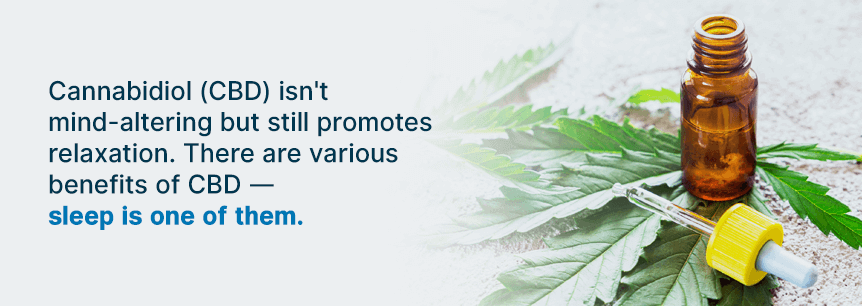
Because of its ability to relieve pain, reduce anxiety and promote mental clarity and focus, CBD has grown very popular. It can promote alertness and reduce daytime sleepiness. It can even reduce anxiety without having an impact on sleep-wake cycles.
Researchers have made much progress in understanding how the compound produces its pain-reducing, anti-inflammatory and calming effects in the body. But, they’re still learning. What they do know is CBD interacts with various proteins, receptors and other brain chemicals. These interactions generate changes in the activity of hormones, neurotransmitters and other cells in the body and brain. CBD seems to affect many of the functions of the body through these interactions, including sleep-wake cycles.
Because CBD reduces anxiety, it’s helpful in decreasing sleep problems and improving quality of sleep. CBD might increase overall amounts of sleep, improving insomnia. It was found to reduce insomnia in individuals suffering from chronic pain.
CBD reduces daytime sleepiness and stimulates alertness in smaller doses — important for consistency and strength of the sleep-wake cycle and daytime performance.
Tetrahydrocannabinol (THC) is the primary psychoactive cannabinoid in marijuana. It helps with pain relief and reducing nausea. Studies show it has sedative effects, making it simpler to fall asleep. There’s also growing evidence that suggests it could improve breathing during sleep, making it a potential therapy for treating sleep disorders like obstructive sleep apnea.
While cannabinoids have taken the spotlight for their potential benefits for mood, pain and sleep, terpenes are also beginning to show promise and seem to impact marijuana’s effects, including how it affects sleep. Researchers are still learning how terpenes affect the mind and body. But, they think terpenes may enhance the effects of different cannabinoids as well as directly affect the body in various ways.
Terpenes are aromatic, tiny molecules in medical marijuana that create its taste and smell. They’re in cannabis as well as many natural fruits, plants and flowers. There are different terpene combinations in various strains of medical weed, and they contribute to the different effects of different strains when we consume them.
Science shows terpenes affect mood, energy, alertness and sleepiness.
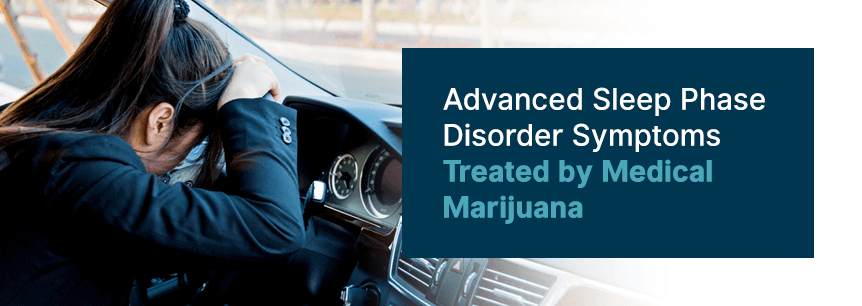
Obviously, the main symptom of advanced sleep phase disorder that medical marijuana can potentially help treat is sleep problems. These sleep problems can be either disrupted sleep patterns that can lead to insomnia or the strong urge to fall asleep at inappropriate times such as while eating or driving.
Research shows marijuana’s effectiveness in improving sleep. Many individual users report anecdotal evidence that they’ve had great results with cannabis improving their sleep.
Marijuana during the night time is beneficial since it can alleviate insomnia symptoms directly. Many individuals report that when they compare it with conventional sleep medicines, marijuana works much better, isn’t addictive and leaves them feeling better the following day.
After checking the laws of your state to ensure medicinal cannabis is legal, to start using medical weed as a treatment for your advanced sleep phase disorder, you’ll need to talk with a certified medical marijuana doctor and receive a written recommendation. Then you’ll need to obtain a medical marijuana card. Once you’ve received your card, you can then begin shopping for your cannabis products at a local dispensary.
While you can eat marijuana in foods like cakes and brownies, in the past people have mostly smoked the herb. Smoking medical weed allows you to titrate the dose more carefully by looking for the subjective effects before you take another puff.
Many cannabis patients are now using other methods to take their medical marijuana, including vaping the herb to absorb THC and avoid inhaling smoke.
Regarding edible marijuana, when you eat medical pot, it could lead to potent effects that you’ll notice sometime after you consume them with no way for you to reduce the dose. The setting in which you use your medical marijuana for advanced sleep phase syndrome can also affect your experience.
Indica strains seem to be the most relaxing and therefore meant for sleep.
Some good indica strains to help with insomnia or similar sleep problems are:
If you’re struggling with the strong urge to fall asleep during passive activities, you may want to try a sativa strain which is more energizing and uplifting. While not helpful when you’re trying to fall asleep, sativa strains can help keep you alert so you don’t fall asleep during the day.
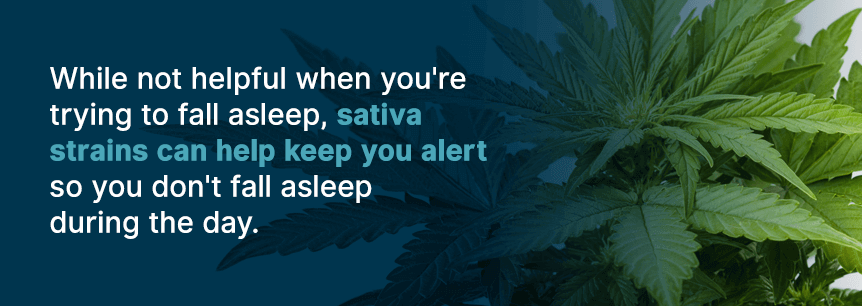
Top strains for their energizing effects are:
Cannabis can significantly improve your advanced sleep phase syndrome symptoms, but you need to understand its possible side effects fully. When you compare them with traditional medications, the effects are usually mild. Once the herb leaves your body, the side effects go away, so they’re not long-lasting.
Some possible side effects of medical marijuana are:
When you compare medical pot with prescription sleep aids, you’ll see the benefits of trying this treatment over the other. Prescription sleep aids can be addictive. With research into cannabis becoming more legally and practically viable by the day, patients with symptoms of advanced sleep phase syndrome may soon have enough reasons to choose this treatment.
Before starting your treatment, you’ll want to sit down with your cannabis doctor and discuss all potential side effects. Most will be mild, but it doesn’t hurt to know what to expect.
Cannabis has been known for a while to be helpful in getting a good night’s sleep. Patients have used it successfully to treat a handful of sleep disorders, including these two:
Now that you’ve learned a little about how medical pot can help treat symptoms of advanced sleep phase disorder, let’s dive into exactly what the condition is, its symptoms, causes, other treatments and more.
Advanced sleep phase disorder or syndrome is a circadian rhythm condition in which you experience excessive sleepiness and the necessity to sleep earlier than desired or what is socially acceptable. It can also correspond to earlier than desired waking times. The early morning awakening, with ASPD, occurs after a regular night’s sleep, which means that other than the timing of sleep, the patient experiences a normal sleep cycle.
As an example, if you have advanced sleep phase disorder, you may need to go to bed between 6 p.m. and 9 p.m. and then wake between 2 a.m. and 5 a.m., while still receiving a full seven to eight hours of sleep.
Advanced sleep phase disorder is estimated to affect about one percent of the adult population, and older adults experience it more commonly, according to the American Sleep Association.
The condition may be underdiagnosed because many people who have it manage to arrange work and social engagements at times that accommodate the condition and don’t interfere with their lives. Others may have less accommodating social or professional requirements that cause disruptions to their abilities to sleep or lead to less than ideal coping mechanisms.
Some in the medical community believe the loss of response to light as patients age causes advanced sleep phase disorder. This loss of light responses may be the result of cataracts or other lens problems associated with aging.
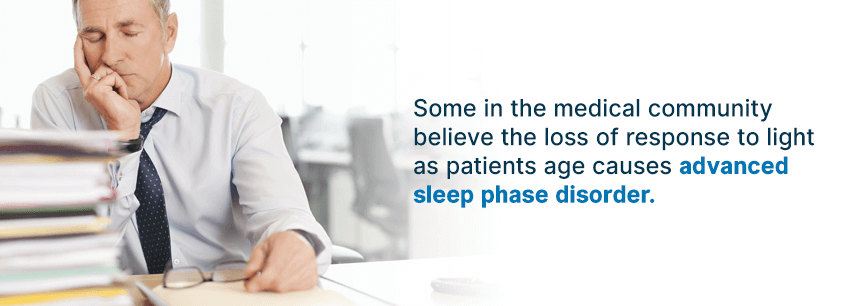
Other contributing factors believe to impact a person’s susceptibility to advanced sleep phase disorder include:
While everyone has his or her unique symptoms associated with any disorder, some are fairly universal with advanced sleep phase disorder. They include:
Because other conditions cause early morning awakenings, you must meet specific criteria before being diagnosed with advanced sleep phase disorder.
This will likely require a sleep study to determine if the patient may have undiagnosed sleep apnea or if current treatment for diagnosed sleep apnea is sufficient.
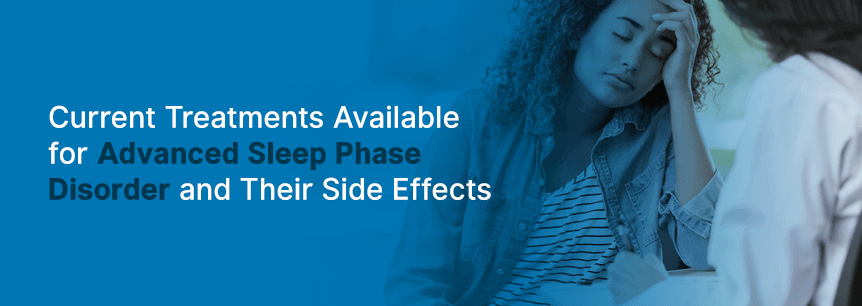
There are essentially two primary types of treatment that physicians and sleep specialists widely used to treat advanced sleep phase disorder. One is a bright light therapy that attempts to artificially “reset” the body clock, and another is a behavioral therapy that attempts to retrain your body to sleep and awaken at more socially acceptable or normal times.
All in all, medical cannabis seems to be a better alternative for advanced sleep phase disorder than sleep aids and other medications.
If you’re experiencing sleep problems because of advanced sleep phase syndrome, exploring cannabis as an affordable supplemental or alternative treatment for your symptoms could help improve your sleep. At Marijuana Doctors, we can help you find a cannabis doctor and dispensary so you can begin treating your condition.
Book your appointment today to find relief from advanced sleep phase syndrome so you can get better sleep and be more alert during the day.
Find A Doctor Find A Dispensary